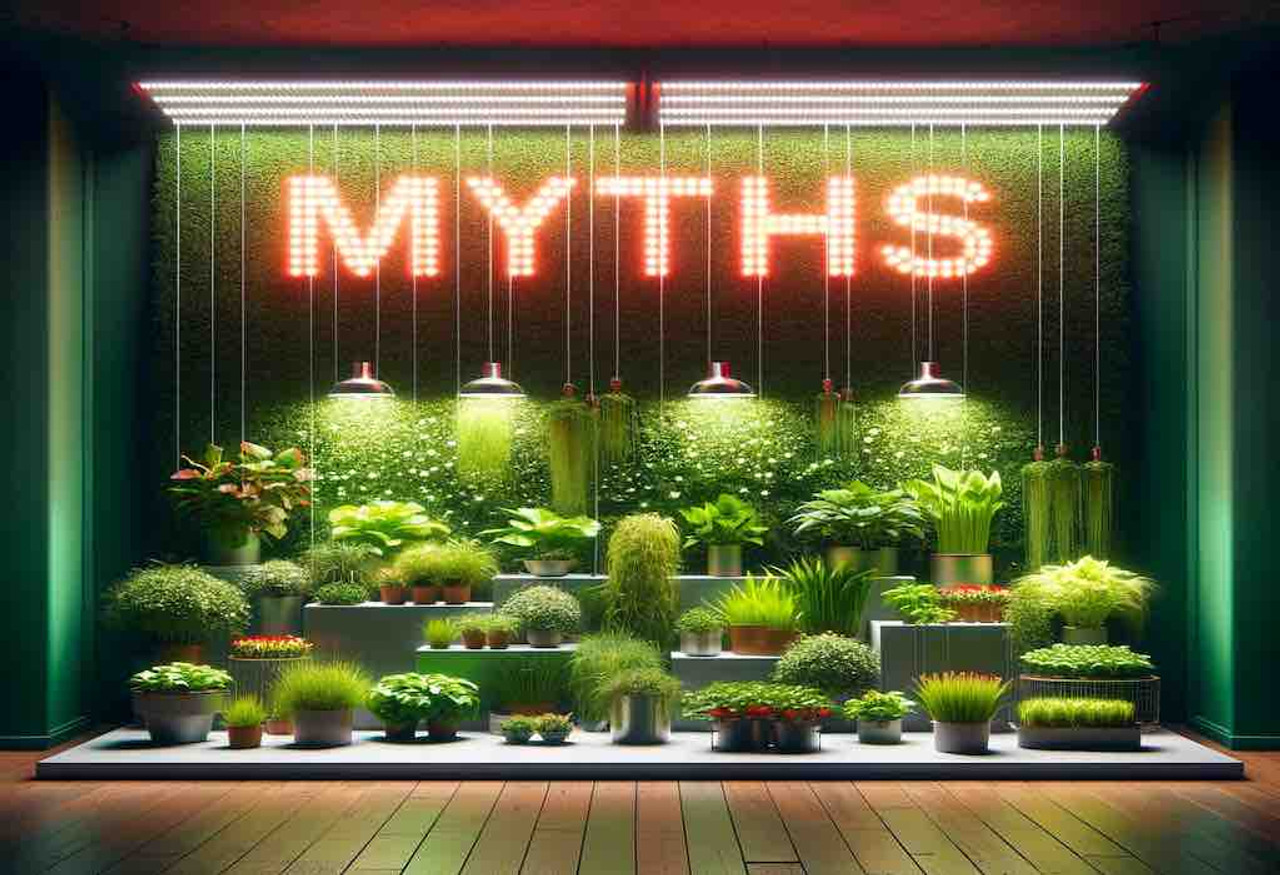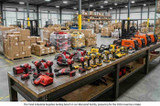Debunking Myths About Indoor Gardening with Grow Lights
Indoor gardening has emerged as a beacon of sustainability and self-sufficiency, offering a lush oasis where outdoor space is scarce or seasons limit year-round growth. Growing lights are central to this green revolution, pivotal in simulating the sun’s rays, thus ensuring plants receive the vital energy they need to photosynthesize, grow, and thrive. Yet, numerous misconceptions can deter aspiring gardeners from the glow of grow lights. This article aims to shed light on these myths, illuminating the path for enthusiasts to cultivate their indoor gardens. confidently
Key Takeaway:
Grow lights can revolutionize indoor gardening, enabling you to cultivate various plants regardless of natural light limitations. By understanding and addressing the specific needs of your plants, you can create a thriving indoor garden. Remember, success lies in choosing the right grow light, positioning it correctly, and adjusting the light exposure according to the plants' growth stages. Embrace the process, experiment, and enjoy the lush, vibrant growth your grow lights enable.
Myth #1: Grow Lights Are Too Expensive for Home Use
The notion that grow lights are a luxury beyond the average gardener's reach is a myth ripe for debunking. Today's market brims with options catering to all budgets, from modest setups to more advanced systems. LED grow lights, in particular, stand out for their energy efficiency and longevity, representing a cost-effective solution over time. By choosing wisely, even gardeners with tighter budgets can find suitable, energy-efficient LED options that offer savings on electricity bills, proving that starting an indoor garden can be both affordable and sustainable.
Myth #2: Grow Lights Can Harm Plants
Another common misconception is that the intensity of grow lights could be detrimental, potentially scorching the delicate foliage of houseplants. However, understanding that different plants have varied light needs dispels this myth. While it's true that too much of any good thing can become harmful, grow lights are designed with various settings to mimic the natural sunlight spectrum. With options to adjust both intensity and duration, gardeners can tailor their light setup to suit the specific needs of each plant, ensuring they promote rather than hinder growth.
Myth #3: Indoor Gardening with Grow Lights is Complicated
Many shy away from indoor gardening, believing it requires expertise beyond their grasp. This myth couldn't be further from the truth. Setting up an indoor garden with grow lights can be straightforward, with many systems designed for ease of use and simplicity. From plug-and-play options to user-friendly kits that guide you through each step, starting an indoor garden is accessible to beginners. Moreover, a wealth of resources is available to support new gardeners on their journey, from online forums to detailed guides.
Myth #4: Grow Lights Don't Offer Real Benefits Over Natural Light
A common myth posits that grow lights are inferior to natural sunlight, providing little added benefit to plants. However, grow lights have a distinct advantage—they offer consistency and control over the light's intensity and spectrum, elements often at the mercy of weather and seasonal changes outdoors. This control allows indoor gardeners to extend growing seasons, improve plant health, and even enhance certain growth aspects through tailored light spectra. Research and expert opinions underscore the effectiveness of grow lights, noting marked improvements in growth rates, yields, and plant health compared to reliance on variable natural light alone.
Myth #5: All Grow Lights Are the Same
Navigating the world of grow lights can be daunting, especially with the misconception that all grow lights are created equal. There's a diverse range of grow light technologies, each with its advantages. LED lights are celebrated for their energy efficiency and longevity, making them ideal for long-term indoor gardening. Fluorescent lights, particularly T5 and CFL bulbs, are suitable for seedlings and low-light plants. HID lights, while more power-intensive, are excellent for larger, sun-loving plants due to their high output. Understanding the specific needs of your indoor garden can guide you to the most suitable grow light type, ensuring your plants receive the right light spectrum and intensity for optimal growth.
Myth #6: Grow Lights Are Only for Experienced Gardeners
The belief that grow lights are reserved for the green-thumbed experts is yet another myth that needs dispelling. Grow lights have democratized indoor gardening, making it accessible and achievable for novices and seasoned gardeners. Many beginners have found success starting their indoor gardening adventures with grow lights, thanks to user-friendly systems and a supportive community of fellow gardeners. Tips for novices include starting small, experimenting with different plants and light settings, and leveraging online resources and forums for advice and support.
Addressing Environmental Concerns
Concerns about the environmental impact of using grow lights are valid, but modern advancements have significantly mitigated these worries. Today's grow lights, especially LEDs, are designed with energy efficiency in mind, consuming less power and emitting less heat than their predecessors. For those particularly conscious of their ecological footprint, exploring renewable energy sources to power grow lights or opting for energy-efficient models can further reduce environmental impact. When done thoughtfully, indoor gardening can be a sustainable practice that aligns with eco-friendly living principles.
Conclusion
The journey into indoor gardening, illuminated by the advancements in grow light technology, is shrouded in myths but rich with potential. From the initial skepticism surrounding the affordability and complexity of grow lights to concerns over their environmental impact, we've shed light on the truths that enable anyone to confidently embark on this green endeavor. The essence of cultivating plants indoors lies in debunking these myths and embracing growing light technology's nuanced, adaptable nature. Whether nurturing herbs on a windowsill or managing a full-fledged indoor vegetable garden, the right grow lights can transform your approach, yielding lush, vibrant growth irrespective of the weather outside.
The transition towards indoor gardening, supported by grow lights, represents more than just an opportunity for year-round cultivation; it is a step towards self-sufficiency, a deeper connection with the food we consume, and a testament to the resilience of plant life under our care. As we look forward, the innovation in grow light technology and indoor gardening practices promises an even brighter future for enthusiasts and novices alike.
Are you ready to turn over a new leaf and start your indoor gardening journey? Let the light in and dispel the darkness cast by common misconceptions about grow lights. Visit Tend Industrial Supplies at tendsupplies.com and discover how our range of grow lights and indoor gardening supplies can elevate your green space. Whether you're taking your first steps into gardening or looking to refine your approach with the latest grow light technology, we're here to support your growth every step. Share your indoor gardening stories, challenges, and triumphs at sales@tendsupplies.com. Let's cultivate a community passionate about bringing the outdoors in, growing our food, and nurturing our connection to the natural world.
Summary of the Misconceptions of Grow Lights
| Myth | Summary |
|---|---|
| Grow Lights Are Too Expensive | This myth suggests that grow lights are a significant financial burden for home gardeners. However, a variety of affordable and energy-efficient options, particularly LED lights, debunk this by offering long-term savings. |
| Grow Lights Can Harm Plants | Some believe that grow lights might be too intense, potentially damaging plants. The truth is that with proper selection and placement, grow lights can be tailored to the specific needs of different plants, promoting healthy growth without harm. |
| Indoor Gardening with Grow Lights is Complicated | The assumption here is that setting up an indoor garden with grow lights requires expert knowledge. In reality, many grow light systems are user-friendly, and resources are available to support beginners. |
| Grow Lights Don't Offer Real Benefits Over Natural Light | This myth underestimates grow lights, assuming they can't match the benefits of natural sunlight. Grow lights actually allow for the control and consistency of light exposure, which can be superior to the variability of natural light, enhancing plant growth and extending growing seasons. |
| All Grow Lights Are the Same | A common misconception is that there is little difference between grow light options. Different types of grow lights (LED, Fluorescent, HID) offer varying benefits, such as efficiency and light spectrum, making some better suited for specific plants than others. |
| Grow Lights Are Only for Experienced Gardeners | This myth posits that only those with extensive gardening experience can benefit from using grow lights. In fact, grow lights can significantly assist beginners in successfully starting their indoor gardening ventures. |
| Grow Lights Are Environmentally Unfriendly | Concerns that grow lights significantly contribute to environmental degradation persist. Modern, energy-efficient grow lights, especially when powered by renewable energy sources, minimize ecological impact, making indoor gardening with grow lights a sustainable practice. |
FAQs
1. How long should I keep grow lights on for my indoor plants?
Most indoor plants thrive with about 12 to 16 hours of light per day. It's crucial to mimic the natural day-night cycle, giving your plants a period of darkness to rest. The exact duration can vary depending on the plant species and the intensity of your grow lights, so it's beneficial to research your plants' specific needs.
2. Can grow lights cause harm to my plants?
When used correctly, grow lights are not harmful to plants. Issues arise when lights are too close or intense, leading to "light burn," causing leaves to turn yellow or brown. To prevent this, ensure your lights are positioned at the recommended distance, and use lights with adjustable intensity to cater to the needs of different plants.
3. Are LED grow lights better than fluorescent ones?
LED grow lights are generally more energy-efficient, have a longer lifespan, and can provide a full spectrum of light, which is beneficial for plant growth. While cost-effective and suitable for starting seeds or growing low-light plants, fluorescent lights may not offer the same intensity or spectrum as LEDs. The choice depends on your specific gardening needs and budget.
4. Can I use regular LED bulbs as grow lights?
Regular LED bulbs can be used for growing plants, mainly if they emit a full spectrum of light. However, specialized LED grow lights are designed to provide a more tailored spectrum and intensity to support plant health and growth more effectively. Investing in grow lights is advisable for optimal results, especially with fruiting or flowering plants.
5. Do all plants need to grow lights when grown indoors?
While many plants benefit from supplemental lighting, especially in low-light environments or during winter, not all plants require growth lights. Some species thrive in indirect light and may not need additional lighting. Assessing the natural light in your indoor space and understanding your plants' specific light requirements will help determine if grow lights are necessary.









